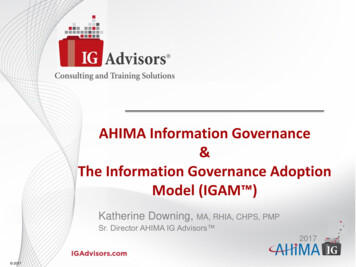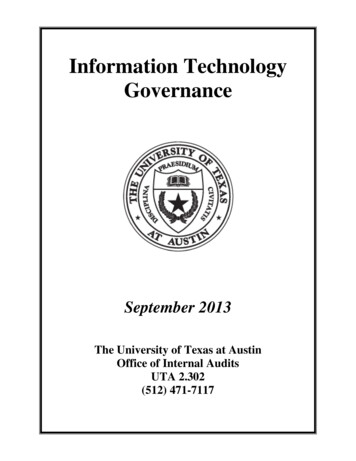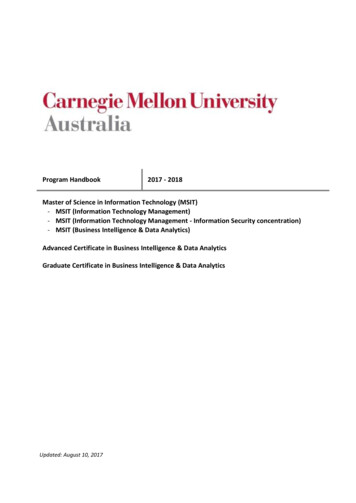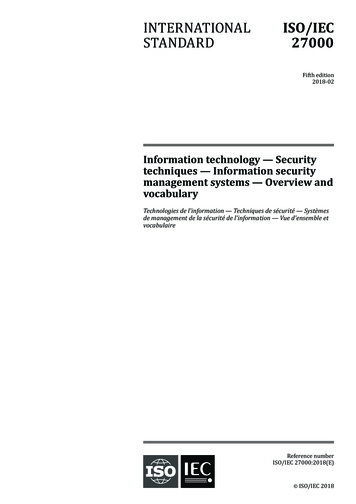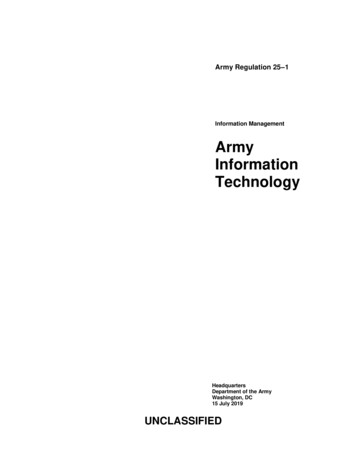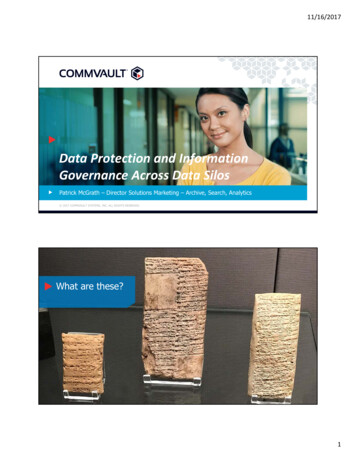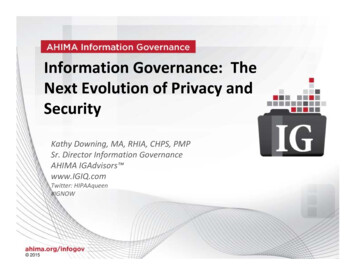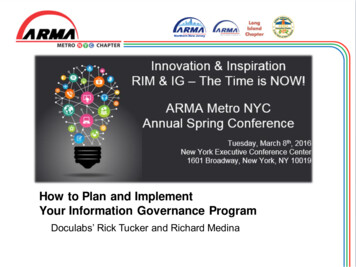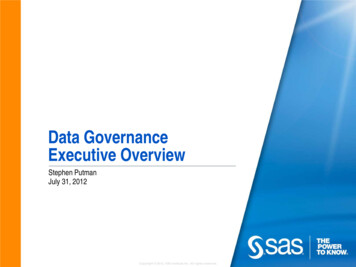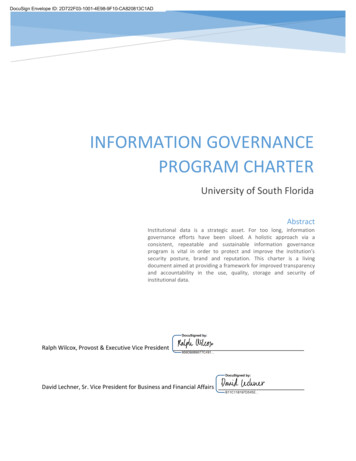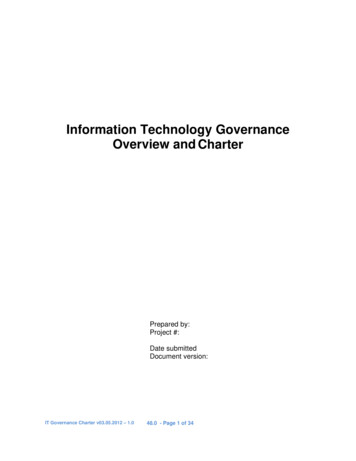
Transcription
Information Technology GovernanceOverview and CharterPrepared by:Project #:Date submittedDocument version:IT Governance Charter v03.05.2012 – 1.048.0 - Page 1 of 34
Document HistoryVersionDateAuthorRevision DescriptionsApprovalsThe signatories below have authority to approve the Information TechnologyGovernance teSignatureNameTitleDateSignatureNameTitleDateIT Governance Charter v03.05.2012 – 1.048.0 - Page 2 of 34
Table of Contents1INTRODUCTION TO INFORMATION TECHNOLOGY GOVERNANCE . 42INTEGRATED GOVERNANCE PROCESSES . 52.12.22.33Enterprise Strategic and Operational Planning . 52.1.1 IT Asset Portfolio. 62.1.2 IT Project Portfolio and Project Prioritization . 6Enterprise IT Project Management. 10Enterprise Architecture. 10CITY GOVERNANCE ROLES AND RESPONSIBILITIES . 123.1Roles and Responsibilities . 123.1.1 Executive Management . 133.1.2 Investment Committee . 133.1.3 I.T. Steering Committee . 143.1.4 Architectural Design Team (ADT) . 153.1.5 Direct the PMO in response to any project conflicts, issues or decisionsthat cannot be resolved by the PMO Project Management Office . 163.1.6 Individual Project Governance . 174SUPPORTING GOVERNANCE DOCUMENTS AND TEMPLATES . 185CITY IT STEERING COMMITTEE CHARTER . 216CITY INVESTMENT COMMITTEE CHARTER . 28IT Governance Charter v03.05.2012 – 1.048.0 - Page 3 of 34
1 Introduction to Information TechnologyGovernanceThe goal of Technology Governance is to ensure that a balanced mix of City of Chesapeaketechnology investments is aligned with strategic and cross-functional business objectives.Governance activities are targeted at understanding the issues and strategic importance ofIT, enabling the enterprise to sustain its operations, and implementing the strategies requiredto advance IT in response to future needs of the City. Governance practices aim at ensuringthat the expectations for IT are met and IT risks are mitigated.The two main components of governance are:1. The creation of decision-making mechanisms, whether committees, review boards, orwritten policies2. The assignment of decision-making authority and accountabilityInformation Technology Governance drives decisions in three main areas:1. IT strategy2. IT project investments3. IT architectureThe decision making structure for the City Governance include the following entities: The Architectural Design Team (ADT)The IT Steering CommitteeThe Investment CommitteeThe City’s Executive OfficeActing in a supporting role to the above entities are the following: IT Project Management Office (PMO)IT Program/Application Change ManagementIndividual project implementation teamsThis governance process is focused on a broad perspective referred to as “enterprisearchitecture”, which is a City-wide framework used to incorporate business processes,information flows, applications and infrastructure in support of City goals as identified by theCity Council of Chesapeake.Some of the many benefits expected from effectively and consistently following a governanceprocess include: Facilitate executive decision making and aid in IT strategic planningIT Governance Charter v03.05.2012 – 1.048.0 - Page 4 of 34
Aid in project and portfolio management, thereby ensuring focused use of Cityresources in support of strategic goalsEnsure compliance with City standardsEnsure capacity planning and IT resource utilization requirements are addressedCreate a centralized source from which to see all existing IT assets, initiatives, andpotential investment opportunitiesIncrease interoperability among and across City IT applicationsImprove ability to share data and services between City systemsProvide visibility regarding potential reuse of existing applications2 Integrated Governance ProcessesInformation Technology Governance encompasses the three enterprise processes illustratedin Figure 1.Figure 1 – Integrated Governance Processes2.1 Enterprise Strategic and Operational PlanningThe Information Technology Governance process starts with establishing IT objectives fromboth a strategic and operational perspective. From there, priorities are set to ensure that therequired IT assets are available and that new project initiatives are aligned with the directionof the City.Within this process and approach, City Executive and IT Management focuses on: Aligning IT strategy with a well-defined business strategy that is supported by clearlydocumented business processesIT Governance Charter v03.05.2012 – 1.048.0 - Page 5 of 34
Ensuring that IT delivers against the strategy through clearly defined expectations andmeasurementDirecting IT strategy to balance investments between systems that support theenterprise as-is, as well as transform IT capabilities to enable the business to growand support new programs and/or directivesMaking deliberate decisions about the focus of IT resources, including personnel,contracted services, hardware and software assetsThe primary outcome of the Enterprise Strategic and Operational Planning process is theestablishment of an IT Asset Portfolio and IT Project Portfolio that supports the City’s goals.2.1.1 IT Asset PortfolioThe IT Asset Portfolio focuses on current operations. Two categories of assets are includedin this portfolio: hard assets and soft assets. Hard assets are the physical items of value,such as hardware, computing facilities, production applications and tools, and personnel.Soft assets include items such as data, services, applications, capabilities, knowledge andskills.Management of these assets involves maximizing efficiency and effectiveness of dailyutilization. Many of the hard assets have a finite lifespan. Therefore, another responsibility ofmanaging the IT Asset Portfolio is to properly retire assets that have reached the end of thereuseful life. Within the IT Asset Portfolio, it is also important to identify areas that requireoperational improvement. Deficiencies or sub-optimization of existing assets are identifiedand incremental improvement strategies are developed.2.1.2 IT Project Portfolio and Project PrioritizationThe IT Project Portfolio is focused on transforming the business to its desired future statebased on the City’s strategic direction and operational improvement needs.A standardized process for approving and prioritizing potential projects within the City’s ITProject Portfolio will be executed under the direction of the Architectural Design Team (ADT),IT Steering Committee, Investment Committee, and the Executive Office. The ADT willensure the project is in compliance with City technology standards. The IT SteeringCommittee considers the recommendation of the ADT regarding technical compliance andmakes a determination of suitability of a project based on strategic alignment, feasibility, andresource investment. The Investment Committee focuses on securing funding sources.Figure 2 provides an overview of four governance decision points that are used to determinethe IT Project Portfolio mix.IT Governance Charter v03.05.2012 – 1.048.0 - Page 6 of 34
IT Governance ProcessBusiness Unit completes aRequest-For-Services(RFS) and notifies PMO of“Pending” projectBusiness Unit submits project proposaland other supporting documentationGovernance SphereProcess Approval #1Architectural Design Team (ADT)reviews for compliance to IT standardsProcess Approval #2I. T. Steering Committee determines ifapproval is warranted – CIO chairProcess Approval #3Investment Committee determines iffunds are available – Budget Dir. chairProcess Approval #4City Manager ApprovalBusiness Unit notifies PMO project is “active”Figure 2 - Project Approval GovernanceThere are two key players both of which can be the same individual: the Project Sponsortypically a Department Head and the Business Unit Project Initiator. No project will goforward without a Project Sponsor. Project concepts are to be initially documented by theProject Sponsor on a Request For Services (RFS) form available on CityNet. The RFS isused to capture at a high level the purpose and objectives of the project, the anticipateddeliverables, and any out-of-scope areas, as well as identify possible funding sources. TheIT Governance Charter v03.05.2012 – 1.048.0 - Page 7 of 34
Business Unit Project Initiator notifies the Project Management Office (PMO) of a “pending”project. Some additional tools, forms, and templates are as follows:1. The ADT Compliance Review explains the ADT review process2. The “ADT Preliminary Checklist” covers some preliminary issues and attempts toremind you of additional cost factors that might not have been considered up to thispoint in time3. The “Steering Committee - Project Proposal Checklist” use of which should help youprepare for a Steering Committee presentation.4. “Project Proposal Guide” use of which will help you focus on the business process,requirements, strategic alignment issues, Total Cost of Ownership, business case,feasibility study (if needed) among others.5. The “Investment Committee - Project Proposal Checklist” use of which should help youprepare for an Investment Committee presentation. Additionally, it will help you delvemore deeply into the financials for projected Net Present Value (NPV), Internal Rateof Return (IRR), Return on Investment (ROI), Cash Flows among others.6. The Request for Proposal (RFP) or Request for Information (RFI) are familiar andstandard vehicles in use today.7. The Statement of Work (SOW) is a familiar and standard vehicle in use today.8. The “ADT Compliance Checklist” to help ensure compliance with City IT technologystandards as specified in the “CoC Technology Standards” documentThese documents and others are available to assist the Business Unit Project Initiator andProject Sponsor in thinking through, capturing, and communicating the value and feasibility ofthe project being proposed. The IT contact is available to provide guidance in the use ofthese tools and templates and will assist the Project Sponsor (Sponsor) and Business UnitProject Initiator (Initiator) as needed.Having completed the Request for Services (RFS) and become familiar with the ADTCompliance Review process in (1) above the Sponsor and the Initiator then complete item (2)the ADT Preliminary Checklist and submits it to the ADT as an alert that an ADT ComplianceChecklist is likely to follow.The “Steering Committee - Project Proposal Checklist” and “Investment Committee - ProjectProposal Checklist” are completed by the Sponsor and Initiator with what is known about theproject to-date and provides a set of evaluation criteria from which the project can beassessed in terms of alignment with the City’s strategy, customer needs, directives andmandates, business practices, anticipated risks, system requirements, and resource / costrequirements. System objectives and business requirements are further defined, andalternative approaches to satisfy the requirements are outlined in the included business case.The Request for Proposal (RFP) and Statement of Work (SOW) are familiar documentswithin the City and are completed at this time.Finally, the ADT Compliance Checklist is completed using the above mentioned documentsand helps to serve as the last preparation before formal presentations begin. If the ProjectIT Governance Charter v03.05.2012 – 1.048.0 - Page 8 of 34
Sponsor agrees with the project as described in these documents and would like to move theproject forward for further evaluation and consideration, the next step is Approval Process#1 and is the first of four required approvals in the governance process. The project ispresented to the Architectural Design Team (ADT) by the Project Sponsor and the ProjectInitiator. Upon completion and review the ADT makes a recommendation to the ChiefInformation Officer (CIO) who then determines the appropriateness of submission to theSteering Committee. The Project Sponsor and Business Unit Project Initiator appear beforethe Steering Committee to address any member questions regarding the project. Uponreview of the presented information, the Steering Committee determines whether or not it isreasonable to proceed to the Investment Committee and prepares to re-prioritize the projectportfolio and assign resources to do the necessary project planning based on: the recommended project implementation approach and IT support of the City’s goalsand objectivesthe City’s ability to successfully execute the new project once the Project Portfolio hasbeen reviewed and reprioritized accordinglyThis presentation to the I. T. Steering Committee is Process Approval #2 and is the secondof four approvals in the project approval process at the executive management level.Upon receiving approval from the Steering Committee the Project Sponsor and Business UnitProject Initiator proceed to the Investment Committee to ensure there is adequate fundingand if not then present the case for securing approval for funding. This presentation may beaided by preliminary quotes from prospective vendors and documents previously developedand mentioned above. This presentation to the Investment Committee is Process Approval#3 and the third of four approvals in the project approval process.Upon receiving approval by the Investment Committee the Project Sponsor seeks the CityManager’s approval where the project is reviewed in light of the goals and objectives of theCity Council among other considerations. Upon receiving approval the Business Unit ProjectInitiator informs the PMO to change the status of the project from “pending” to “active”. Thispresentation to the City Manager is Process Approval #4 and is the last approval neededbefore submitting Request for Proposal (RFP) if required to Procurement or any follow upactions to obtain the desired technology.Bear in mind a “GO/NO GO” decision is made at each of the four Process Approvals. If theproject receives the approvals, the project is formally included in the Project Portfolio, thePortfolio is adjusted by the CIO, and resources obtained to accommodate the effort. At thispoint Governance transfers to the Business Unit Project Initiator and a designated ProjectManager falling under the umbrella of Enterprise IT Project Management.However, on an ongoing basis, dynamic adjustment of the project portfolio mix is essential.There must be a disciplined, repeatable process by which a project idea develops into aproposal that is then evaluated, approved, prioritized, and initiated. Conversely, discipline isneeded to properly terminate projects when appropriate. Information is provided to theIT Governance Charter v03.05.2012 – 1.048.0 - Page 9 of 34
various committees via the PMO Project Portal, regarding the status of projects within theportfolio. This information along with new project proposal submissions is used to prioritizeprojects and adjust the project portfolio as required.2.2 Enterprise IT Project ManagementWhile the prior process is focused on execution at the portfolio level, the Project ManagementOffice (PMO) focuses on execution at the individual project level. Consistent, effective use ofthe PMO is essential to a high performing IT Project Portfolio. The PMO tracks the projectstatus from “pending” through “completion” and close out.2.3 Enterprise ArchitectureThe Enterprise Architecture process involves establishing and ensuring compliance with theCity of Chesapeake’s technical standards to improve the City’s ability to serve customers,use assets efficiently, and promote best practices.Within the City, architecture compliance is driven by the ADT. Technology projects aretypically categorized into two types of projects; Software Development projects andCommercial Off-the-Shelf (COTS) projects which can be hosted in-house or offsite.The ADT chair and technical support team is an internal Department of InformationTechnology body that reviews and approves technical tools used by the City in support of theCity’s infrastructure, again ensuring technical architecture compliance and the ability toleverage tools across the infrastructure.Figure 3 below illustrates an overview of the City’s architecture review and governancedecision points (I. e. ADT Approval to Proceed). Additional details on the ADT process canbe found on CityNet under Department of Information Technology (quick links) – ADTdocuments.IT Governance Charter v03.05.2012 – 1.048.0 - Page 10 of 34
Figure 3 – IT Conceptual Architecture Design ReviewSystem requirements, definitions, general system design etc. are documented in a RequestFor Proposal (RFP), Statement of Work (SOW), and ADT checklists created by the BusinessUnit Project Initiator with help from the IT contact and submitted to the ADT. After a SoftwareDevelopment project has been approved by the ADT and the appropriate project scoping andplanning has occurred, the project then moves on to the sphere of project governance at theexecutive level whereby the project is prioritized by the CIO within the IT Steering Committeeand funding examined by the Investment Committee.The first ADT decision point occurs following the completion of the Preliminary Checklist andserves as a reminder of what needs to be considered by the Business Unit Project Initiator.The second ADT decision point occurs after the ADT Compliance Checklist is completed.The recommended design is evaluated via the ADT check lists and the ADT determineswhether or not the design conforms to the City’s standards. The ADT then makes arecommendation to the CIO.IT Governance Charter v03.05.2012 – 1.048.0 - Page 11 of 34
3 City Governance Roles and ResponsibilitiesThe City Information Technology Governance structure consists of the organizationalcomponents show below in figure 4ArchitecturalDesignTeam (ADT)I.T. SteeringCommitteeCIO - ChairInvestmentCommitteeBudget Dir. ChairCityManagerFigure 4: Technology Governance StructureThis structure provides the foundation to consistently initiate, prioritize and align IT assetsand projects across the entire City. The goal of this structured governance approach is tostrategically evaluate the City’s projects in the following areas: The cost to undertake a project (both internal resources and external procurements)The risk involved in the projectThe expected business value or returnAlignment with stated City Council prioritiesThe alignment of project initiatives with the City’s technical standards.This process will enable the enterprise to coordinate, analyze, report on, and support itsvarious projects with the appropriate tools, techniques, training and guidance. Articulatingthe status of projects (in terms of scope, time, cost and resources), the inter-relationshipsbetween projects, and the impacts of one project on another provides City managementcritical information necessary to consistently obtain superior business results.Specific roles and responsibilities for City Executive Management, the Architectural DesignTeam (ADT), the I.T. Steering Committee, the Investment Committee, and individual projectimplementation teams are describe below.3.1 Roles and ResponsibilitiesThe City’s Information Technology Governance model consists of five layers ofaccountability.These accountability layers are:1. Executive Management2. The Investment Committee chaired by the Budget Director and members consisting
IT Governance Charter v03.05.2012 – 1.0 48.0 - Page 9 of 34 Sponsor agrees with the project as described in these documents and would like to move the project forward for further evaluation and consideration, the next step is Approval Process #1 and is the first of four required approvals in the governance process. The project isFile Size: 349KBPage Count: 34
